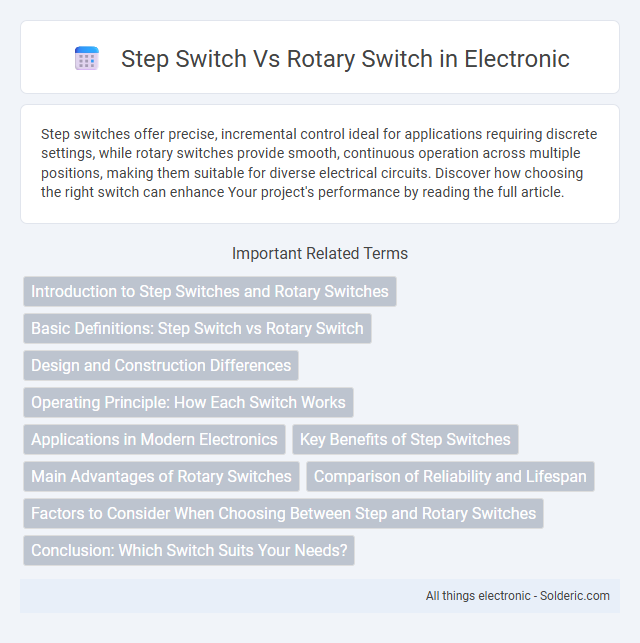Step switches offer precise, incremental control ideal for applications requiring discrete settings, while rotary switches provide smooth, continuous operation across multiple positions, making them suitable for diverse electrical circuits. Discover how choosing the right switch can enhance Your project's performance by reading the full article.
Comparison Table
| Feature | Step Switch | Rotary Switch |
|---|---|---|
| Definition | Mechanical switch advancing contacts step-by-step | Switch that rotates to select circuit paths |
| Operation | Linear stepping movement | Rotational movement |
| Number of Positions | Limited discrete steps | Multiple selectable positions |
| Application | Telephone exchanges, stepping relays | Multi-circuit selection, control panels |
| Durability | High mechanical wear due to stepping | Robust with smooth rotation |
| Size | Generally compact | Varies, often larger due to rotary mechanism |
| Complexity | Simple design | More complex due to multiple contacts |
| Typical Use | Sequential switching tasks | Direct selection of circuits |
Introduction to Step Switches and Rotary Switches
Step switches are electromechanical devices that change circuit connections by stepping through a sequence of positions, commonly used in telephone systems and industrial controls for precise, incremental switching. Rotary switches, featuring a rotating spindle that selects different circuit paths, provide multiple positions for discrete circuit connections, often utilized in audio equipment and instrumentation for mode or input selection. Both switch types enable multi-position control but differ in operation; step switches move incrementally in fixed steps, while rotary switches allow radial rotation to any specified contact.
Basic Definitions: Step Switch vs Rotary Switch
A step switch is an electromechanical device that moves between discrete positions with each activation, commonly used for sequential circuit control. A rotary switch allows the user to select one of several circuits by rotating a knob to different fixed positions, offering multiple connection points within one unit. Both switches manage electrical paths, but step switches advance incrementally while rotary switches provide direct access to various circuit configurations.
Design and Construction Differences
Step switches feature a compact design with discrete positions activated by a stepping mechanism, enabling precise, incremental control often used in older telecommunication and industrial equipment. Rotary switches consist of a central shaft rotating to connect multiple terminals, offering smooth and continuous rotation for selecting various circuits in audio, lighting, and control panels. Your choice depends on whether you need the defined position indexing of step switches or the versatile, multi-contact arrangement of rotary switches.
Operating Principle: How Each Switch Works
Step switches operate by sequentially moving contacts through discrete positions via a ratchet mechanism, allowing control of electrical circuits in defined steps. Rotary switches function by rotating a central shaft or knob to align a rotating contact or wiper with various fixed terminals, enabling multiple circuit selection in a continuous or stepped rotational motion. Both switches rely on mechanical movement to establish distinct electrical pathways, but step switches advance linearly through positions, while rotary switches rotate to achieve contact selection.
Applications in Modern Electronics
Step switches are commonly used in applications requiring precise, incremental control such as volume adjustments in audio equipment or selecting discrete settings in industrial machinery. Rotary switches are favored in modern electronics for their ability to handle multiple circuit paths, making them ideal for multi-speed fans, channel selectors in radios, and mode selectors in appliances. Your choice between these switches depends on the complexity of the control needed and the number of selectable positions in the electronic device.
Key Benefits of Step Switches
Step switches offer precise control with distinct, reliable position increments, making them ideal for applications requiring accurate multi-position selection. Their compact design enhances space efficiency, while robust construction ensures durability and long operational life under various environmental conditions. You benefit from simplified wiring and maintenance, reducing downtime and improving overall system performance compared to rotary switches.
Main Advantages of Rotary Switches
Rotary switches offer multiple selectable positions, allowing you to control several circuits with a single device, which is ideal for complex applications requiring precise settings. Their compact design saves space while providing durability and reliable operation under frequent use. This makes rotary switches a versatile choice for devices needing smooth transitions between various electrical pathways.
Comparison of Reliability and Lifespan
Step switches generally offer higher reliability and longer lifespan due to their simple mechanical design and fewer moving parts, reducing wear and tear over time. Rotary switches, while versatile, tend to have more contact points that can degrade with frequent use, potentially shortening their operational lifespan. When choosing between the two, your decision should consider step switch durability for long-term applications versus rotary switch flexibility for varied circuit configurations.
Factors to Consider When Choosing Between Step and Rotary Switches
When choosing between step switches and rotary switches, consider the application's required number of selectable positions and the switch's durability under repeated operations. Step switches provide distinct, incremental position control ideal for simple or binary selections, while rotary switches offer multiple positions and versatility for complex circuit configurations. Evaluate space constraints and ease of installation, as rotary switches often require more panel space compared to compact step switches.
Conclusion: Which Switch Suits Your Needs?
Step switches offer precise incremental control ideal for applications requiring distinct position settings, such as volume or speed adjustments. Rotary switches provide versatile multi-position options suitable for selecting various circuits or functions in complex devices. Choosing between them depends on the need for exact step changes or broader selection flexibility in your project or equipment.
Step switch vs Rotary switch Infographic

 solderic.com
solderic.com